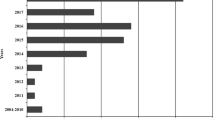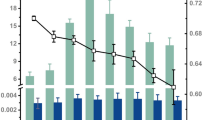Abstract
To characterize the deep subsurface environment of Rainier Mesa, Nevada Test Site, rock samples were taken from tunnels U 12b, U12g, U12p, and U 12n, which varied in depth from 50 m to 450 m and in gravimetric moisture content from 4% to 27%. Values for total count, viable count, biomass, Simpson diversity, equitability, similarity coefficient, and number of distinct colony types indicated microbiological variability between samples. Viable counts ranged from less than 1 × 101 to 2.4 × 105 CFU g dry wt−1 of rock. Direct counts and enumeration based on phospholipid determination indicated larger numbers of cells g dry wt-1 of rock than viable counts. Simpson diversity indices, equitability, and numbers of distinct colony types varied from 3.00 to 8.05, 0.21 to 0.89, and 7 to 19, respectively, and indicated heterogeneity between samples. Each distinct morphotype was purified and characterized. Gram reaction, morphology, metal and antibiotic resistances, and metabolic activities of each isolate confirmed spatial variability among microbiota isolated from different locations. Most probable numbers of nitrifying, sulfur oxidizing, and sulfur-reducing bacteria were below the limit of detection in all samples, while the numbers of nitrogen fixing bacteria ranged from below the level of detection to 7.8 × 102 cells g dry wt−1 of rock sample, and the numbers of dentrifying bacteria ranged from below the level of detection to greater than 1.6 × 103 cells g dry wt−1 of rock sample.
Similar content being viewed by others
References
Amy PS, Haldeman DL, Ringelberg D, Hall DH, Russell C (1992) Comparison of identification systems for classification of bacteria isolated from water and endolithic habitats within the deep subsurface. Appl Environ Microbiol 58:3367–3373
Analytab Products (1987) API Rapid NFT identification codebook. Analytab Products, Plainview, New York
Atlas RM (1984) Use of microbial diversity measurements to assess environmental stress. In: Klug MJ, Reddy CA (ed) Current perspectives in microbial ecology. American Society for Microbiology, Washington, DC pp 540–545
Balkwill DL (1989) Numbers, diversity, and morphological characteristics of aerobic, chemoheterotrophic bacteria in deep subsurface sediments from a site in South Carolina. Geomicrobiol J 7:33–51
Balkwill DL, Fredrickson JK, Thomas JM (1989) Vertical and horizontal variations in the physiological diversity of the aerobic, chemoheterotrophic bacterial microflora in deep southeast coastal plain subsurface sediments. Appl Environ Microbiol 55:1058–1065
Beloin RM, Sinclair JL, Ghiorse WC (1988) Distribution and activity of microorganisms in subsurface sediments of a pristine study site in Oklahoma. Microbial Ecol 16:85–97
Benson HJ (1985) Microbiological applications; a laboratory manual in general microbiology. 4th ed. Wm. D. Brown Publisher, Dubuque, Iowa p 427
Colwell RR, Austin B (1981) Systemtics. In: Gerhardt P, Murry RGE, Costilow RN, Nester EW, Wood WA, Kreig NR, Phillips GB (eds) Manual of methods for general bacteriology. American Society for Microbiology, Washington, DC p 446
Department of Energy (1989) Subsurface science program. Transitional program plan. (DOE/ER-0328) US Department of Energy, Washington DC
Findlay RH, King GM, Watling L (1989) Efficacy of phospholipid analysis in determining microbial biomass in sediments. Appl Environ Microbiol 55:2888–2893
Fliermans CB (1989) Microbial life in the terrestrial subsurface of southeastern coastal plain sediments. Hazardous Waste and Hazardous Materials 6:155–171
Fliermans CB, Balkwill DL (1989) Microbial life in deep terrestrial subsurfaces. Bioscience 39:370–377
Frederickson JK, Garland TR, Hicks RJ, Thomas JM, Li SW, McFadden KM (1989) Lithotrophic and heterotrophic bacteria in deep subsurface sediments and their relation to sediment properties. Geomicrobiol J 7:53–66
Fredrickson JK, Balkwill DL, Zachara JM, Li SW, Brockman FJ, Simmons MA (1991) Physiological diversity and distributions of heterotrophic bacteria in deep cretaceous sediments of the Atlantic coastal plain. Appl Environ Microbiol 57:402–411
Ghiorse WC, Balkwill DL (1983) Enumeration and morphological characterization of bacteria indigenous to subsurface environments. Dev Ind Microbiol 24:213–224
Ghiorse WC, Balkwill DL (1985) Microbiological characterization of subsurface environments. In: Ward CH, Gieger W, McCarty PL (eds) Ground water quality. John Wiley and Sons, New York, pp 536–556
Ghiorse WC, Wilson JT (1988) Microbial ecology of the terrestrial subsurface. Adv Appl Microbiol 33:107–173
Hattori T (1980) A note on the effect of different types of agar on plate count of oligotrophic bacteria in soil. J Gen Appl Microbiol 26:373–374
Hersman L, Purtymun W, Sinclair J (1988) Preliminary microbial analysis of the vadose zone, Parajito Plateau, New Mexico. Abstr Annu Meet Amer Soc Microbiol, American Society for Microbiology, Washington DC, p 252
Jiminez L (1990) Molecular analysis of deep-subsurface bacteria. Appl Environ Microbiol 56:2108–2113
Olsen RA, Bakken LR (1987) Viability of soil bacteria: Optimization of plate-counting technique and comparison between total counts and plate counts within different size groups. Microb Ecol 13:59–74
Phelps TJ, Fliermans CB, Garland TR, Pfiffner SM, White DC (1989) Methods for recovery of deep terrestrial subsurface sediments for microbiological studies. J Microbiol Methods 9:267–280
Reasoner DJ, Geldreich EE (1985) A new medium for the enumeration and subculture of bacteria from potable water. Appl Environ Microbiol 49:1–7
Simpson EH (1949) Measurement of diversity. Nature (London) 163:688
Sinclair JL, Ghiorse WC (1989) Distribution of aerobic bacteria, protozoa, algae, and fungi in deep subsurface sediments. Geomicrobiol J 7:15–31
Smibert RM, Kreig NR (1981) Systematics. In: Gerhardt P, Murry RGE, Costilow RN, Nester EW, Wood WA, Kreig NR, Phillips GB (eds) Manual of methods for general bacteriology. American Society for Microbiology, Washington DC, pp 419, 432, 438
Trolldenier G (1973) The use of fluorescence microscopy for counting soil microorganisms. Bull Ecol Res Comm (Stockholm) 17:53–59
Troussellier M, Legendre P (1981) A functional evenness index for microbial ecology. Microb Ecol 7:283–296
Van Veldhoven PP, Mannaerts GP (1987) Inorganic and organic phosphate measurements in the nanomolar range. Anal Biochem 161:45–48
Wilson JM, Griffin DM (1975) Water potential and the respiration of microorganisms in the soil. Soil Biol Biochem 7:199–204
Wong PTW, Griffin DM (1976) Bacterial movement at high matric potentials. I. In artificial and natural soils. Soil Biol Biochem 8:215–218
Author information
Authors and Affiliations
Additional information
Offprint requests to: P. S. Amy.
Rights and permissions
About this article
Cite this article
Haldeman, D.L., Amy, P.S. Bacterial heterogeneity in deep subsurface tunnels at Rainier Mesa, Nevada test site. Microb Ecol 25, 183–194 (1993). https://doi.org/10.1007/BF00177194
Received:
Revised:
Issue Date:
DOI: https://doi.org/10.1007/BF00177194




